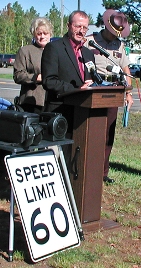
Minnesota Department of Public Safety, Office of Traffic Safety
Excessive or illegal speed is the most commonly reported factor in fatal crashes, especially during summer, the deadliest period on Minnesota roads. Each year in Minnesota, speed contributes to about 150 traffic deaths and 7,000 injuries.
The Minnesota Department of Public Safety (DPS) and Minnesota Department of Transportation (MnDOT) launched an extensive speed control project in September 2005 involving engineering, enforcement and education. This project, dubbed HEAT (highway enforcement of aggressive traffic), involved speed limit studies and adjustments, increased speed enforcement and education.
The goals of the program are to:
- Reduce fatalities and severe injuries on interstates and expressways
- Reduce high travel speeds on those roadways
- Prevent excessive speeding on the roads selected that go to 60 mph
- Increase public perception of enforcement presence
The program was supported in the first 12 months by $3 million in federal funds, of which $2.5 million was for enforcement (roughly 50,000 hours of enforcement by State Patrol, county sheriffs and local police); $350,000 was for paid media, primarily radio; and $150,000 was for data collection, analysis and evaluation.
DPS and MnDOT consider last year's HEAT effort successful and a key effort of the state's Toward Zero Deaths programming for reducing traffic deaths. Fatal and severe-injury crashes dropped on all road types during HEAT enforcement, and dropped significantly in several cases, compared to the previous five-year average. Minnesota's 494 deaths in 2006 was the lowest number of annual traffic deaths since 1945. The 2006 death tally reflects 65 fewer people killed, or a nearly 12 percent decrease, from 559 traffic deaths in 2005. Both enforcement results and reduced travel speeds were significant.
During the first year of HEAT, officers stopped nearly 89,000 vehicles, cited nearly 34,000 drivers for illegal speed and issued 45,000 speed warnings. Another 14,000 citations were issued for non-speed-related offenses.
Most significantly, according to a University of Minnesota study following HEAT last year, the number of vehicles traveling over 70 mph decreased by 11 percent on metro-area freeways where the speed limit increased to 60 mph. In greater Minnesota on highways where speed limits were raised to 60 mph, the number of vehicles traveling over 70 mph dropped nearly 29 percent. On four-lane, divided, 65 mph roads where the speed limit remained the same, the number of vehicles traveling over 75 mph also decreased by almost 29 percent. Most notable was a 43 percent decrease in number of vehicles traveling in excess of 80 mph on rural 70 mph freeways.
A public education campaign was conducted. News conferences were held across the state to launch HEAT. Nearly 18,000 radio spots were aired, generating more than 27 million gross impressions. Editorial coverage was generated by quarterly news releases, customized by State Patrol districts, announcing enforcement and speed travel data. Many TV and radio stories were generated.
HEAT was re-launched statewide in June 2007 and is funded with $1.5 million, providing nearly 25,000 of enforcement hours and additional paid media support.
More Information
- Final Project Report
- Press Release
- Program Overview
- Speed Enforcement Stats
- Lt. Mark Peterson
Minnesota State Patrol
mark.peterson@state.mn.us - Dennis Smith
Minnesota Department of Public Safety
Office of Communications
dennis.smith@state.mn.us
